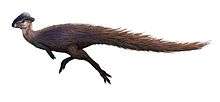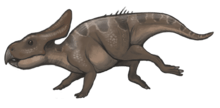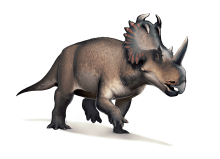Asiaceratops
| Asiaceratops | |
|---|---|
| Scientific classification | |
| Kingdom: | Animalia |
| Phylum: | Chordata |
| Clade: | Dinosauria |
| Order: | †Ornithischia |
| Family: | †Leptoceratopsidae |
| Genus: | †Asiaceratops Nesov et al., 1989 |
| Type species | |
| Asiaceratops salsopaludalis Nesov et al., 1989 | |
| Species | |
| |
Asiaceratops (meaning "Asian horned face") is a genus of herbivorous ceratopsian dinosaur. It lived during the Late Cretaceous. Its fossils have mainly been found in Uzbekistan; a referred species is known from China and Mongolia.
Discovery and naming
The type species, Asiaceratops salsopaludalis, was formally described by Lev Nesov, L.F. Kaznyshkina and Gennadiy Olegovich Cherepanov in 1989. The generic name combines a reference to Asia with ~ceratops, "horned face". The specific name means "of the salt marsh" in Latin. In the same publication Microceratops sulcidens Bohlin 1953 was renamed into a second species of Asiaceratops: Asiaceratops sulcidens.[1]
The holotype of Asiaceratops salsopaludalis, CCMGE 9/12457, was found in Uzbekistan in a layer of the Khodzhakul Formation dating from the early Cenomanian, about ninety-nine million years old. It consists of a part of a left maxilla. Some other fragments were in 1989 referred to the species, among them teeth and a phalanx. In 1995 Nesov referred more material, from three Uzbek sites, mostly skull elements and a partial humerus, of individuals of different ages.[2]
Asiaceratops has often been considered a nomen dubium, in view of the limited holotype material.[3]
Classification
Asiaceratops belonged to the Ceratopsia (the name is Greek for "horned faces"), a group of herbivorous dinosaurs with parrot-like beaks which thrived in North America and Asia during the Cretaceous Period, which ended roughly 66 million years ago. All ceratopsians became extinct at the end of this era.
In 1995 Nesov assigned Asiaceratops to a Asiaceratopsinae of its own.[2] Recent cladistic analyses indicated, despite the presumed status as a nomen dubium, a basal position in the Leptoceratopsidae.[4]
Diet
Asiaceratops, like all ceratopsians, was an herbivore. During the Cretaceous, flowering plants were "geographically limited on the landscape", and so it is likely that this dinosaur fed on the predominant plants of the era: ferns, cycads, and conifers. It would have used its sharp Ceratopsian beak to bite off the leaves or needles.
See also
References
- ↑ L.A. Nessov, L F. Kaznyshkina, and G.O. Cherepanov. 1989. [Mesozoic ceratopsian dinosaurs and crocodiles of central Asia]. In: Bogdanova and Khozatskii (eds.), Theoretical and Applied Aspects of Modern Palaeontology pp 144-154
- 1 2 L.A. Nessov, 1995, Dinozavri severnoi Yevrazii: Novye dannye o sostave kompleksov, ekologii i paleobiogeografii, Institute for Scientific Research on the Earth's Crust, St. Petersburg State University, St. Petersburg 156 pp
- ↑ H. You and P. Dodson. 2004. "Basal Ceratopsia". In: D.B. Weishampel, H. Osmolska, and P. Dodson (eds.), The Dinosauria (2nd edition). University of California Press, Berkeley, pp 478-493
- ↑ M.J. Ryan, D.C. Evans, P.J. Currie, C.M. Brown, and D. Brinkman, 2012, "New leptoceratopsids from the Upper Cretaceous of Alberta, Canada", Cretaceous Research 35(1): 69-80
| Wikispecies has information related to Asiaceratops |


